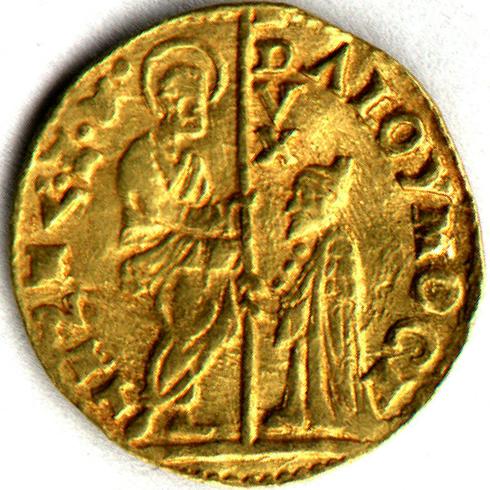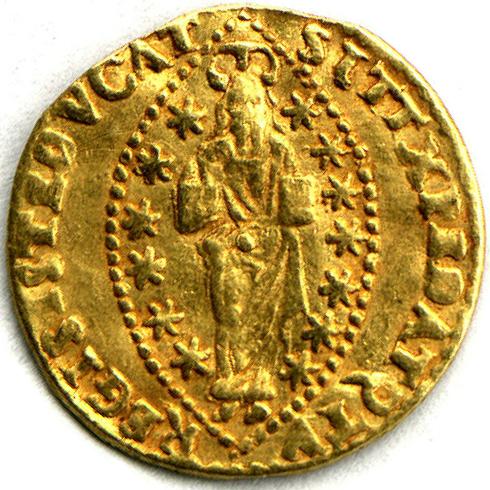| SPECIFICATIONS | |
| Denomination | Ducat |
| Metal XRF | Gold Au.995 |
| Alloy | Ag%Cu 0.85 |
| Type | Struck |
| Diameter | 21.6 mm |
| Thickness | 1.3 mm |
| Weight Legal | 3.494 gms |
| Weight | ~3.50 gms |
| Shape | Round |
| Edge | Plain |
| DieAxis | O° |
| Mint | Venice |


|

| 
| ||||||||||||||||||||||||||
| Friedberg #1263 | ||||||||||||||||||||||||||||
It was called a Ducat, the name inscribed on it, but later known as zecchino or sequin. Varying only a little in design it was minted for over 500 years from 1284 till the end of the republic in 1797. The extreme 0.999 purity of the Gold made it a World currency. It was a standard of weight 53.75 grains Troy, or 3.4940 grams with 0.1122 oz of AGW (Actual Gold Weight).
Codrington lists the sequins of following Doges during the Portuguese Era as been found in Lanka.
| F1246 | 1523-1539 | Andrea Gritti | .AND.GRITI | 9 stars 5-point |
| F1255 | 1556-1559 | Lorenzo Priuli | LAV.PRIOL | 12 stars 5-point |
| F1263 | 1570-1577 | Alvise Mocenigo I | ALOY.MOCE | 13 stars 6-point |
| F1270 | 1585-1595 | Pasquale Cicogna | PASC.CICON | 19 stars 5-point |
The VF Ducat was scanned at 600dpi and displayed at 300dpi. This sequin was not found from circulation in Lanka. It was purchased on ebay in 2001 January from Classical Numismatic Group, Inc. in Lancaster Pennsylvania who guarantees it's authenticity. This Ducat is exactly as illustrated in Le Monete Di Venezia by Papadopoli, the definitive publication on coins of Venice.
Various changes in design offer a means of identifying each ducat uniquely. The lettering in the legend and the presence of . or *'s, the character of the Doge's cap, the disposition of the figure of Christ and the nimbus in the oval, the number and arrangement of the stars and the number of points in each star. The presence or absence of a beard, evidently depended upon the appearance of the individual Doges.
On reverse the legend had the word DVCAT which changed after 1655 to DVCA. The staff had nothing or a small flag on top and changed after 1659 to a cross. Between 1655 to 1659 there was a new doge every year and coincides with this transition.
Note the abbreviation of the name and the difference of a . or a * of the four Doges with the name Alvise Mocenigo.
| F1263 | 1570-1577 | Alvise Mocenigo I | ALOY.MOCE | 13 stars 6-point |
| F1358 | 1700-1709 | Alvise Mocenigo II | ALOY*MOCENI* | 16 stars 6-point |
| F1379 | 1722-1732 | Alvise Mocenigo III | ALOY*MOCENI. | 16 stars 6-point |
| F1421 | 1763-1779 | Alvise Mocenigo IV | ALOY.MOCEN. | 16 stars 5-point |
See also Venetian Gold Ducat from 18th century when the Dutch were in Lanka.
Text edited from
* Ceylon Coins and Currency By H. W. Codrington. Colombo 1924
Page 169 Chapter XIII Miscellaneous - II Venetian
* The Venetian Gold Ducat and its Imitations by Herbert E. Ives,
edited and annotated by Phillip Grierson. ANS 1954.
I thank Benjamin Bell of CNG for the drawings from Papadopoli and the copy of Ives & Grierson, a very interesting monograph on these ducats.